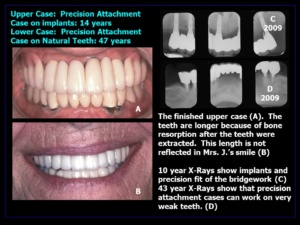Thinking Outside the Box

“Thinking outside the box,” says author Dustin Wax, “is more than just a business cliché. It means approaching problems in new, innovative ways; conceptualizing problems differently; and understanding your position in relation to any particular situation in a way you’d never thought of before.” Thinking outside the box is often talked about, but rarely applied. Most practitioners are complacent with what they know.
For those who embrace “outside the box thinking,” a tool box with the appropriate armamentarium is absolutely essential. “If all you have is a hammer,” the saying goes, “everything looks like a nail.” Today—more than ever before—dentists only seem to have implants in their treatment armamentarium. There is an absolute epidemic of tooth extraction and implant placement—and the implant treatment option is being stretched beyond its capabilities. Dentists abhor removable prosthetics, so patients almost always get fixed bridgework on these implants. Often the implant abutments are clearly not strong enough to provide adequate support.
One of the best treatment options a dentist can have in his or her armamentarium is the double-tilt precision attachment case. This type of case has perhaps the best track record of any restoration in Dentistry and was invented in 1906. My father and I documented these cases for more than 70 years and clearly the double-tilt precision attachment case has greater longevity than fixed bridgework cases.
Unlike conventional removable restorations, the double-tilt prosthesis does not transmit lateral forces to the abutment teeth. These removable restorations can be made on natural tooth or implant abutments. They are worn 24 hours a day and only removed for hygiene. There is minimal maintenance and they do not require powder or paste. The Double-Tilt precision attachment case is a great adjunct to implant therapy because it allows implants to be placed where they are most effective and avoid areas with poor anatomy that would require bone grafts and sinus lifts.
What a tragedy that the overwhelming majority of dentists know nothing about this treatment option! It is my mission to ensure that the the knowledge of how to make a double-tilt precision attachment case does not end up in the slag-heap of dental history! That is why I wrote an entire textbook on this subject (available on this website), and why I am now creating a series of continuing education courses for this website.
Any new skill requires a learning curve, and practitioners must not be afraid to embrace that learning curve if they wish to acquire out-of-the-box skills. Precision Attachment Cases require a precision mindset and many practitioners don’t have the stomach for details. But details distinguish excellence from mediocrity; and longevity from failure.
To be a stellar practitioner, one must recognize that nothing worthwhile is easy at the outset—but mastery is the best reward. Imagine being the only dentist on the block who has the best answers for patients who need restorative treatment! There will be plenty of work when word gets out.
The Double-Tilt Precision Attachment Case is a great treatment choice for many restorative problems. Practitioners will be astounded when the applications are demonstrated. The results that can be achieved are truly mind-blowing!
